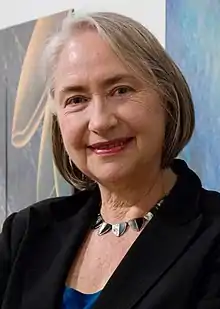
- This is an article about the author and artist. For the Australian character actress, see Deborah Kennedy.
Deborah Kennedy (born 1953) is an American author, educator and artist whose work has focused primarily on environmental advocacy and ecological concerns. She has also lectured on art and art history at Santa Clara University and San Jose City College. She has received attention in media for her art projects, most notably along the Berlin Wall before its fall in November 1989.[1][2]
Personal life
Deborah Kennedy was born in Connecticut in 1953.[3][4] She received her BA in the Practice of Art in 1983 from the University of California, Berkeley and her MFA in Plastic Arts in 1987 from the San Jose State University.[1][4] She lives in San Jose, California.[5]
Career
Kennedy's project at the Berlin Wall was installed in April 1989. It consisted of over 100 copper and brass plaques with inscriptions sharing hopes and fears of Americans and people from East and West German. Kennedy's project was featured in a 1989 article for the San Jose Mercury News about its impact on the local community and how it allowed communication between East and West Berliners.[6] Kennedy was assisted by the Checkpoint Charlie Museum along with political activist Ranier Hildebrant in mounting her work on the wall under the scrutiny of East German patrol guards.[5] With the fall of the Berlin Wall in November 1989, Kennedy's art was also taken down and collected at least in part as souvenirs by locals.[5]
During the mid-1990s, Kennedy received a California Arts Council grant for a project working with young people at a continuation high school<Maya Suryaraman, >Taggers= paint rosy future: Artist helps teens color their graffiti with dreams, San Jose Mercury News, San Jose, California, 7/29/91, pages 1 and 12a. ref></ref> to produce graffiti murals. In 1997 she was awarded an Artist's Fellowship for Installation Arts from the Arts Council Silicon Valley.[3][7] In that same year she completed work on the public sculpture entitled EcoTech featured at the Champion Light Rail Station in San Jose.[4] From September 1999 to March 2000, Kennedy's artworks were featured at the De Saisset Museum of the Santa Clara University for her exhibition titled Nature Speaks.[8] Kennedy has also taught art and art history at Santa Clara University and currently teaches beginner and intermediate level drawing courses at San Jose City College.[5][9]
Kennedy was commissioned by the San Jose Public Art Program to work alongside sculptor Diana Pumpelly Bates in 2004 on completion of a community project for the Coyote Creek Trail recreational area of San Jose and Santa Clara County, California. Their public artworks, including Kennedy's 'Ripple Effect', are used to promote public awareness of a concrete landing pad and ramp leading to a levee where strollers, wheelchairs, and bicyclists have greater accessibility to the site.[7]
Publications
In 2016 Kennedy published Nature Speaks: Art and Poetry for the Earth (White Cloud Press). It won the 2017 Eric Hoffer and Silver Nautilus poetry book awards for its use of combined visual art and poetry highlighting natural and ecological themes.[10][11] Nature Speaks was also reviewed by Helen Dumont for the August 2017 edition of the Midwest Book Review.[12] As featured in Gravel Magazine, her work includes projects such as "Plankton Follies", a cento, or poem created from lines of existing writing. These poems and ink illustrations emphasize the impact of climate change on plankton while incorporating passages from Barbara W. Tuchman's The March of Folly as well as works by Richard R. Kirby and Christian Sardet.[11]
Kennedy has also served as a contributor for other publications. Her recent written work, Habeas Corpus, was featured in Birds Fall Silent in the Mechanical Sea, a 2019 anthology of poetry and fictional writing.[13]
See also
References
- 1 2 "Deborah Kennedy". Saatchi Art. Accessed 1 August 2019.
- ↑ "Nature Speaks: Art and Poetry for the Earth". LibCal.
- 1 2 (September 1999 – March 2000). "Biography", in Nature Speaks: Environmental Installations by Deborah Kennedy. Santa Clara University. Accessed 1 August 2019.
- 1 2 3 Sanders, Patricia B. (November 1999). "A conversation with Deborah Kennedy", in Artweek, San Jose, California, pp. 13–14.
- 1 2 3 4 Gottschalk, Mary (April 2, 2010). "San Jose artist Deborah Kennedy's art came down along with the Berlin Wall". San Jose Mercury News Accessed 1 August 2019.
- ↑ Burkhart, Dorothy (10 December 1989). "The Writing on the Wall". San Jose Mercury News [Arts & Books section].
- 1 2 City of San Jose Public Art Program (April 2004). "Ripple Effect and Run River Run; Artists: Deborah Kennedy and Diana Pumpelly Bates". SanJoseCA.gov. Accessed 1 August 2019.
- ↑ Northrup, JoAnne S. (September 1999 – March 2000). "Curator's Message", in Nature Speaks" by Deborah Kennedy. Santa Clara University. Accessed 1 August 2019.
- ↑ "Fall 2019 Courses". San Jose City College (sjeccd.edu). Accessed 2 August 2019.
- ↑ "Deborah Kennedy". Leapingclear.org. Accessed 1 August 2019.
- 1 2 Kennedy, Deborah. "Plankton Follies". Gravel Magazine. Accessed 2 August 2019.
- ↑ Dumont, Helen (August 2017). "Helen's Bookshelf", in Midwest Book Review, Volume 16, Number 8. Accessed 2 August 2019.
- ↑ 1 August 2019. "Birds Fall Silent in the Mechanical Sea". Great Weather for Media. Accessed 2 August 2019.